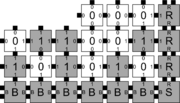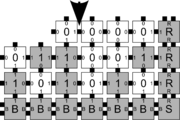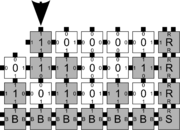Difference between revisions of "Growth Errors"
| (3 intermediate revisions by 2 users not shown) | |||
| Line 1: | Line 1: | ||
| − | In the kTAM, a growth error, an example of which can be seen in the figures below, occurs when one or more sides of a tile which binds to an assembly have glues which do not match the adjacent glues (called | + | In the [[Kinetic Tile Assembly Model (kTAM) | kTAM]], a growth error, an example of which can be seen in the figures below, occurs when one or more sides of a tile which binds to an assembly have glues which do not match the adjacent glues (called glue mismatches). Such a tile may bind with insufficient strength to remain permanently bound, but before it has an opportunity to dissociate, a previously unoccupied neighboring position may be filled by a tile which binds without mismatches, thus resulting in an assembly where every tile has sufficient strength to remain permanently attached despite the mismatch. This essentially "locks" the incorrect tile into place and potentially allows assembly to proceed with an incorrectly placed tile which may cause further deviations from the desired shape or pattern. |
{{multiple image | {{multiple image | ||
| Line 15: | Line 15: | ||
| caption3 = Before the erroneously attached tile can detach, another tile (shown by arrow) attaches with 2 matching bonds so that all tiles are now connected by two correctly formed bonds | | caption3 = Before the erroneously attached tile can detach, another tile (shown by arrow) attaches with 2 matching bonds so that all tiles are now connected by two correctly formed bonds | ||
}} | }} | ||
| + | |||
| + | <br> | ||
| + | <br> | ||
| + | <br> | ||
| + | <br> | ||
| + | <br> | ||
| + | <br> | ||
| + | <br> | ||
| + | <br> | ||
| + | <br> | ||
| + | <br> | ||
| + | <br> | ||
| + | <br> | ||
| + | <br> | ||
| + | <br> | ||
| + | <br> | ||
| + | <br> | ||
| + | ==See also== | ||
| + | [[Facet Errors]] | ||
| + | |||
| + | [[Nucleation Errors]] | ||
[[Category: Terminology]] | [[Category: Terminology]] | ||
| + | [[Category:Self-assembly]] | ||
Latest revision as of 16:04, 27 May 2014
In the kTAM, a growth error, an example of which can be seen in the figures below, occurs when one or more sides of a tile which binds to an assembly have glues which do not match the adjacent glues (called glue mismatches). Such a tile may bind with insufficient strength to remain permanently bound, but before it has an opportunity to dissociate, a previously unoccupied neighboring position may be filled by a tile which binds without mismatches, thus resulting in an assembly where every tile has sufficient strength to remain permanently attached despite the mismatch. This essentially "locks" the incorrect tile into place and potentially allows assembly to proceed with an incorrectly placed tile which may cause further deviations from the desired shape or pattern.


